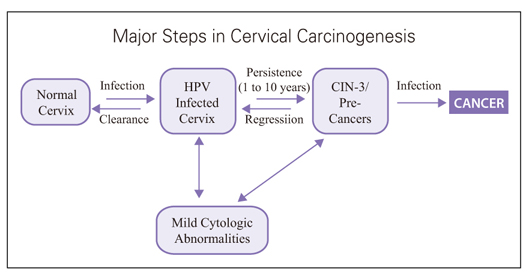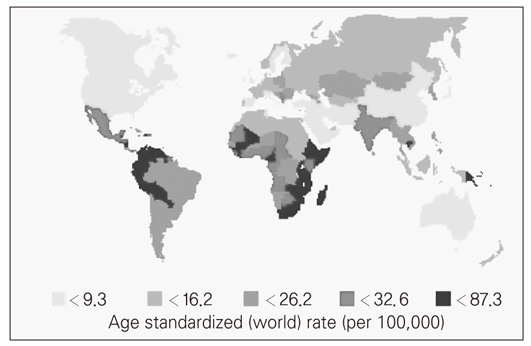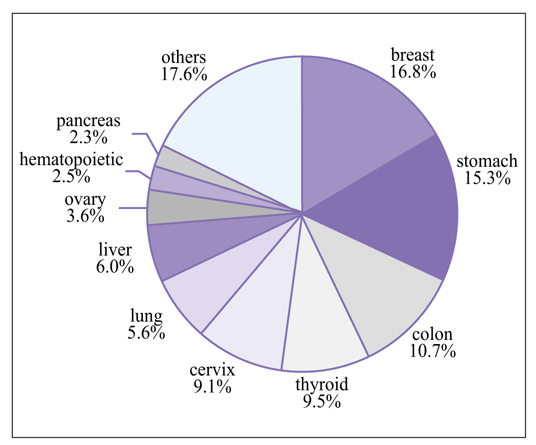J Korean Med Assoc.
2007 Sep;50(9):762-768. 10.5124/jkma.2007.50.9.762.
Epidemiology of Cervical Cancer
- Affiliations
-
- 1Department of Obstetrics and Gynecology, Korea University College of Medicine, Korea. pumplee@kumc.or.kr, yuni105@yahoo.co.kr
- KMID: 2184906
- DOI: http://doi.org/10.5124/jkma.2007.50.9.762
Abstract
- Invasive cancer of the cervix is considered a preventable disease because it has a long preinvasive state, cervical cytology screening programs are currently available, and the treatment of pre-invasive lesions is effective. Cancer of the cervix is the second most common cancer among women worldwide, with an estimated 493,000 new cases and 274,000 deaths in 2002. The highest incidence rates are observed in sub-Saharan Africa, Melanesia, Latin America and the Caribbean, South-Central Asia, and South East Asia. In Korea, cervical cancer is the fifth most common cancer among women with over 3,000 new cases every year. Age-standardized incidence rate (ASR) is 15.5 per 100,000, which is lower than those in developing countries but higher than in western countries such as Europe and North America. The patients' mean parity is 2.59, and the range of age in peak incidence is 40~49 years (29.8%), followed by 50~59 years (21.9%). As the age goes on, more advanced stage cancer is frequent. Squamous cell carcinoma is the most common cell type, and adenocarcinoma is more frequent among those under 60 years old. Operation (56.0%) is the major treatment modality under stage IIa, and concurrent chemoradiation (31.6%) is the major treatment over stage IIb. The 5year survival rate is 73.9%. It is generally thought that human papillomavirus (HPV) test and HPV vaccine might play an important role in lowering the incidence of cervical cancer, and continuous epidemiologic studies will support its usefulness and efficacy.
Keyword
MeSH Terms
Figure
Reference
-
1. Bosch FX, de Sanjose S. Chapter 1: Human papillomavirus and cervical cancer-burden and assessment of causality. J Natl Cancer Inst Monogr. 2003. (31):3–13.
Article2. Snijders PJ, Steenbergen RD, Heideman DA, Meijer CJ. HPV-mediated cervical carcinogenesis: concepts and clinical implications. J Pathol. 2006. 208:152–164.
Article3. Schiffman M, Kjaer SK. Chapter 2: Natural history of anogenital human papillomavirus infection and neoplasia. J Natl Cancer Inst Monogr. 2003. 14–19.
Article4. Parkin DM, Bray F, Ferlay J, Pisani P. Global cancer statistics, 2002. CA Cancer J Clin. 2005. 55:74–108.
Article5. Parkin DM, Whelan SL, Ferlay J, Teppo L, Thomas DB, editors. Cancer incidence in five continents. 2002. vol. VIII. Lyon: IARC Scientific Publications;155.6. Handbooks of Cancer Prevention. Cervix Cancer Screening. 2004. vol 9. Lyon: IARC Press.7. Ries LAG EM, Kosary CL, Hankey BF, Miller BA, Clegg L, Mariotto A, Feuer EJ, Edwards BK, editors. SEER Cancer Statistics Review, 1975-2002. 2005. Bethesda, MD: cited; Available from: http://seer.cancer.gov/csr/19752002/.8. Sant M, Aareleid T, Berrino F, Bielska Lasota M, Carli PM, Faivre J, Sant M, Aareleid T, Berrino F, Bielska Lasota M, Carli PM, Faivre J, Grosclaude P, Hédelin G, Matsuda T, Møller H, Möller T, Verdecchia A, Capocaccia R, Gatta G, Micheli A, Santaquilani M, Roazzi P, Lisi D. EUROCARE Working Group. EUROCARE-3: survival of cancer patients diagnosed 1990-94-results and commentary. Ann Oncol. 2003. 14:S5. 61–118.
Article9. Gondos A, Chokunonga E, Brenner H, Parkin DM, Sankila R, Borok MZ, Gondos A, Chokunonga E, Brenner H, Parkin DM, Sankila R, Borok MZ, Chirenje ZM, Nyakabau AM, Bassett MT. Cancer survival in a southern African urban population. Int J Cancer. 2004. 112:860–864.
Article10. Kamangar F, Dores GM, Anderson WF. Patterns of cancer incidence, mortality, and prevalence across five continents: defining priorities to reduce cancer disparities in different geographic regions of the world. J Clin Oncol. 2006. 24:2137–2150.
Article11. Chung HH, Jang MJ, Jung KW, Won YJ, Shin HR, Kim JW, Lee HP. Members for Gynecologic Oncology Committee of Korean Society of Obstetrics and Gynecology. Cervical cancer incidence and survival in Korea: 1993-2002. Int J Gynecol Cancer. 2006. 16:1833–1838.
Article12. Shin HJK, Won YJ, Park JG. 2002 Annual report of the Korea Central Cancer Registry: based on registered from 139 hospitals. 2004. Korea Cancer Res Treat.13. Korean Society of Obstetrics and Gynecology. Annual Report of Gynecologic Cancer Registry Program in Korea for 2004 (Jan. 1st, 2004-Dec. 31st, 2004). Korean Journal of Obstetrics and Gynecology. 2007. 50:28–78.14. Jay N, Moscicki AB. Human papillomavirus infections in women with HIV disease: prevalence, risk, and management. AIDS Read. 2000. 10:659–668.
- Full Text Links
- Actions
-
Cited
- CITED
-
- Close
- Share
- Similar articles
-
- Response to Letter to Editor “JAK2 V617F Mutation in Cervical Cancer Related to HPV & STIs†by Stephen E. Langabeer
- The epidemiologic status of gynecologic cancer in Thailand
- The Role of Apoptosis in the Carcinogenesis of the Cervical Cancer
- Epidemiology, prevention and treatment of cervical cancer in the Philippines
- “JAK2 V617F Mutation in Cervical Cancer Related to HPV & STIsâ€: Letter







